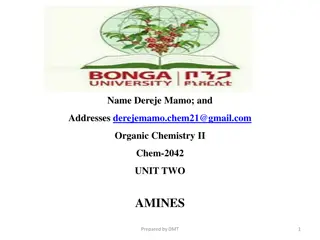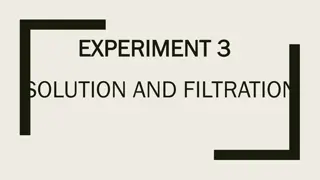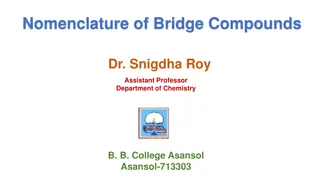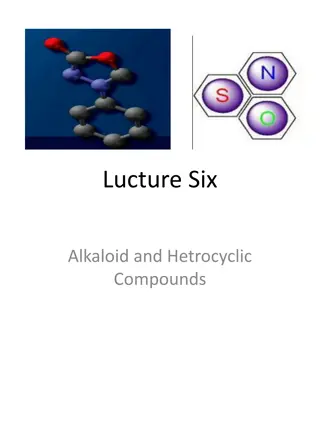Overview of Organic Compounds Nomenclature
Nomenclature of organic compounds involves assigning names based on two main systems - Trivial system and IUPAC system. Trivial system utilizes names related to discoverers or sources, often with Latin or Greek roots. Saturated hydrocarbons, known as paraffins, contain single bonds and are less reactive. Different prefixes like n-, iso-, and neo- are used to specify structures. Additionally, primary, secondary, tertiary, and quaternary carbons play essential roles in organic compound classification, along with alkyl groups derived from paraffin molecules.
Download Presentation

Please find below an Image/Link to download the presentation.
The content on the website is provided AS IS for your information and personal use only. It may not be sold, licensed, or shared on other websites without obtaining consent from the author.If you encounter any issues during the download, it is possible that the publisher has removed the file from their server.
You are allowed to download the files provided on this website for personal or commercial use, subject to the condition that they are used lawfully. All files are the property of their respective owners.
The content on the website is provided AS IS for your information and personal use only. It may not be sold, licensed, or shared on other websites without obtaining consent from the author.
E N D
Presentation Transcript
NOMENCLATURE OF ORGANIC COMPOUNDS Nomenclature means the assignment of names to organic compounds. There are two main systems of nomenclature of organic compounds : 1. Trivial system 2. IUPAC system
Trivial system Oldest system of naming organic compounds Trivial names are based on name of the discoverer or on the source, from which they were obtained. Chosen name had Latin or Greek roots. a) Acetic acid derives its name from vinegar of which it is the chief constituent (Latin: acetum vinegar). Formic acid was named as it was obtained from red ants. The Greek word for the red ants is formicus Urea and uric acid have derived their names from urine in which both are b) c) present.
Saturated hydrocarbons: Hydrocarbons are compounds that contain only carbon and hydrogen. The saturated hydrocarbons contain only single bonds between carbon, atoms. These are also called paraffins (Latin: parum small, and affinis affinity) as these are chemically less reactive They are represented by the general formula CnH2n+2
(a) Prefix n- is used for those paraffins in which all the carbon atoms are in one continuous chain. The prefix n-stands for normal or straight chain. (b) Prefix iso- is used for those paraffins in which methyl group is attached to the second last carbon atom or the continuous chain. (c) Prefix neo- is used for those paraffins in which two methyl groups are attached to the second last carbon atom of the continuous chain.
Primary , secondary, tertiary and quaternary carbons: There are four types of carbons in the carbon chain. (i) Primary carbon: A carbon atom attached to one (or no) other carbon atom is termed primary carbon or 1 carbon atom. (ii) Secondary carbon: A carbon atom attached to two other carbon atoms is termed secondary carbon or 2 carbon atom . (iii) Tertiary carbon: A carbon atom attached to three other carbon atoms is termed tertiary carbon or 3 carbon atom. (iv) Quaternary carbon: A carbon atom attached to four other carbon atoms is termed quaternary carbon or 4 carbon atom.
Normal hydrocarbons contain either only primary or both primary and secondary carbon atoms. No branching is present. Iso-hydrocarbons contain a tertiary carbon atom, i.e. (CH3)2CH-. Neo-hydrocarbons contain a quaternary carbon atom, i.e., (CH3)3C-. Alkyl groups: These are univalent groups or radicals obtained by the removal of one hydrogen atom from a molecule of a paraffin. The symbol 'R' is often used to - represent an alkyl group.
IUPAC System IUPAC: International Union of Pure and Applied Chemistry For naming simple aliphatic compounds, the normal saturated hydrocarbons have been considered as the parent compounds and the other compounds as their derivatives obtained by the replacement of one or more hydrogen atoms with various functional groups. Each systematic name has two or three of the following parts: (i) Root word, (ii) Primary suffix, (iii) Secondary suffix.
(i) Root words: The basic unit is a series of root words which indicate linear or continuous chains of carbon atoms In general, the root word for any carbon chain is alk-.
(ii) Primary suffixes: Primary suffixes are added to the root words to show saturation or unsaturation in a carbon chain.
(iii) Secondary suffixes: Suffixes added after the primary suffix to indicate the presence of a particular functional group in the carbon chain are known as secondary suffixes.
IUPAC Name = Prefix(es) + Root word + Primary suffix + Secondary suffix
IUPAC SYSTEM OF NOMENCLATURE OF COMPLEX COMPOUNDS (A) Rules for Naming Complex Aliphatic Compounds when no Functional Group is Present (Saturated Hydrocarbons or Paraffins or Alkanes) 1. Longest chain rule: The first step in naming an organic compound is to select the longest continuous chain of carbon atoms which may or may not be horizontal (straight). This continuous chain is called parent chain or main chain and other carbon chains attached to it are known as side chains (substituents).
It is possible that sometimes there may be two or more carbon chains of equal lengths in the molecule. In such a case the selected chain should (a) contain maximum number of side chains (substituents) or (b) have the least branched side chains.
2. Numbering of the carbon atoms of the longest chain: The carbon atoms of the longest continuous chain (parent chain) are numbered by arabic numerals 1, 2, 3, 4 ... etc., from one end to the other. The number that locates the position of the substituent is known as Locant. (a) The carbon atoms carrying the first substituent get the lowest possible number (lowest individual number rule or lowest locant rule). (b) In case, there are two or more similar substituents attached to the parent chain, their positions are indicated separately by the prefixes such as di, tri, tetra, etc.
(c) When many substituents are present, the numbering is done from the end where upon the sum of locants is the lowest (Lowest sum rule). d) If there are different alkyl substituents attached to the parent chain, their names are written in the alphabetical order.1t may be noted , that prefixes such as di, tri, etc., are not considered while arranging the substituent alphabetically.
(e) In case, there are different alkyl substituents at equivalent positions, then' numbering of the parent chain is done in such a way that the alkyl group which comes first in the alphabetical order gets the lower number. f) Naming the complex alkyl substituents: When the substituents on the parent chain has itself branched chain, it is named as substituted alkyl' group and its carbon chain is separately numbered in such a way, that the carbon atom directly attached to the parent chain is given number 1'. The name of this complex substituent is written in brackets. To avoid confusion with the number of carbon atoms of the parent chain
[B] Rules for Naming Complex Unsaturated Aliphatic Hydrocarbons (1) Longest chain: In the case of unsaturated hydrocarbons, the longest chain of carbon atoms (parent chain) is so selected as to include the double or triple bond even if it is not the actual longest chain of carbon atoms. When more than one double or triple bond is present in the molecule, the longest chain of carbon atoms is so selected that it includes maximum number of such bonds even if it is not the actual longest chain.
2) A primary suffix is added to the root word to indicate the presence of double or triple bond in the parent chain. For one double bond = Root word + locant + ene For one triple bond = Root word + locant + yne In case the parent chains contain two or more double bonds (two or more triple bonds), the prefixes di-, tri, tetra, etc., are used before primary suffix. For two double bonds = Root word + locant +diene For two triple bonds = Root word + loeant + diyne
(3) Numbering of carbon chain; The parent carbon chain is numbered in a manner so as to give lowest number to that carbon atom linked by double or triple bond even if it violates the rules of saturated hydrocarbons (4) Alkyl groups or other substituents' are numbered, named and placed as prefixes in alphabetical order.
[C] Rules for Naming Complex Aliphatic Compounds Containing One Functional Group (1) Longest chain: The parent carbon chain is so, chosen as to include the functional group even if it is not the actual longest continuous chain. (2) Numbering of. parent chain: The numbering of the parent carbon chain is done in such a way that the carbon linking to functional group gets the lowest number even if there is violation of saturated hydrocarbon rules. When a chain terminating group such as -CHO, -COOH, COOR, -CONH2, -CN, etc., is present as the functional group, it must be assigned number 1. This does not apply to non terminal groups such as >CO, -NH2 and OH, which may or may not be assigned 1.
3) The last 'e' of the primary suffix is dropped and the secondary suffix representing the functional group is added. The number giving the position of the functional group is inserted in the name. (4) The names of the substituents are prefixed to the parent hydrocarbon according to IUPAC rules with alphabetical order without considering the presence of functional group. Halo and nitro groups are considered as substituents. (5) Numerical prefixes di-, tri, tetra-, etc., are attached before the designations of functional group if two or more identical groups are present
(D] Rules for Naming Aliphatic Compounds Having Polyfunctional Groups Seniority Table for Principal Groups (Highest Priority Group at the Top)
1. The first step in the naming of poly functional compounds is the selection of principal functional group. The principal Groups gives the class name of the structure 2. The second step is the selection of Parent chain. The parent chain is so selected that it includes the maximum number of functional groups including the principal group. 3. The third step is the numbering of parent chain. The parent chain is numbered from the side of principal functional group; i.e., it gets lowest number. The following decreasing order of preference for giving the lowest numbers is followed. Principal functional group > Double bond or Triple bond > Substituents. 4. Substituents, side chains and secondary functional groups are named in alphabetical order.
If a molecule contains both carbon-carbon double or triple bonds, the two are treated at par in seeking the lowest number combination. However, if the sum of numbers turns out to be the same starting from either of the carbon chain; then lowest number is given to the C-C double bond. Such compounds are named as alkenynes.























